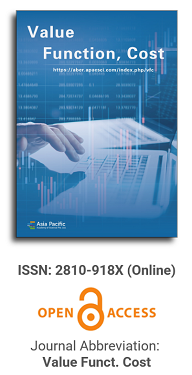
Asia Pacific Academy of Science Pte. Ltd. (APACSCI) specializes in international journal publishing. APACSCI adopts the open access publishing model and provides an important communication bridge for academic groups whose interest fields include engineering, technology, medicine, computer, mathematics, agriculture and forestry, and environment.
The enlightenment of the cost control of regional tourism airports: Taking Airport A as an example
Vol 1, Issue 1, 2021
Download PDF
Abstract
Since the reform and opening up, the civil aviation industry has accelerated its pace of development and achieved world renowned achievements. It has been the world’s second largest civil aviation transportation market for many years. With the rapid development of the civil aviation industry, the construction of transportation airports has always maintained a rapid development trend, the number of airports and business volumes continue to increase, and the annual passenger throughput has basically maintained a double-digit rapid growth. However, at present, the popularity of China’s aviation market is not high, the situation of insufficient capacity of regional airports and large losses has not changed, and a balanced and coordinated development of the airport system has not really taken shape. If China is to move from a major aviation country to an aviation power, it must make up for the shortcomings of insufficient regional airport development as soon as possible. The regional tourism airport is the main component of the regional airport and the most active part of the development of regional airports. It complements the development of regional airports and focuses on accelerating the development of regional airports. Airport A was completed and opened to traffic in May 2017. It is a young and distinctive regional tourist airport. The annual passenger throughput has jumped from more than 100,000 passengers to more than 500,000 passengers in 2019. In the operation process, there are many worth learning from local. Especially in terms of cost control, Airport A creates “airport+” tourist traffic to improve passenger throughput, promotes a transition to management to adjust and optimize the cost structure, green planning and construction to reduce resource and energy consumption, and combines supervision with services to enhance the effectiveness of financial supervision, all of which give a good inspiration for other regional tourism airports to improve cost control.
Keywords
References
- Xia W. Problems and countermeasures in airport cost management (in Chinese). Accountant 2019; 10: 36–37.
- Ma X. Problems and countermeasures in airport cost management (in Chinese). China Civil Aviation 2001; 10: 50–52.
- Shang Z. A brief analysis of enterprise cost control at civil airport (in Chinese). China Business Update 2011; 10: 82–83.
- Wang R, Liu Y. New exploration of airport group cost reduction and efficiency increase under the new normal (in Chinese). Commercial Accounting 2018; 9: 38–40.
- Wen J. Strategic incentive mechanism for domestic airport cost control (in Chinese). Enterprise Reform and Management 2014; 2: 101–102.
- Zhao X. Problems and countermeasures of the cost management system of capital airport (in Chinese). Northern Economy and Trade 2018; 7: 133–135.
- Zhao M. A International Airport cost control research based on lean cost management (Master’s thesis). Inner Mongolia: Inner Mongolia University of Finance and Economics; 2018.
- Michael P. Competitive advantage. Chen L (translator). Beijing: China CITIC Press; 2014.
- Yan J. Construction of enterprise environmental cost control system based on external value chain theory (in Chinese). Communication of Finance and Accounting 2013; 14: 101–102.
Supporting Agencies
Copyright (c) 2021 Value, Function, Cost
License URL: http://creativecommons.org/licenses/by/4.0/

This site is licensed under a Creative Commons Attribution 4.0 International License (CC BY 4.0).
Zhibiao Gao
Nankai University, China

